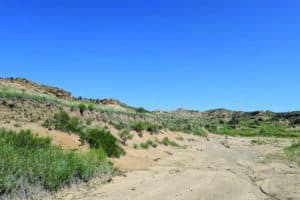Coben Scott is a history graduate, a history buff, and he has explored and researched much of Falcon and the area’s past. Coben’s column, Yesteryear, features stories about the history of the plains.
Fremont’s Fort
In 1842, John C. Fremont was tasked with mapping the Oregon Trail up to the Rockies of Colorado (known then as Unorganized Territory and Indian Country).
In the mountains, there was a rumored easier passageway for travelers along the Cache La Poudre River. This gave hope to the government for not only a safer trail for Oregon pioneers, but also a faster route to the Pacific Ocean. As “The Pathfinder,” Fremont gladly signed up for the job at hand. Accompanying him was a slew of misfit adventurers and explorers, but most notably and handpicked by Fremont for the western wilderness was the legendary mountain man, Christopher “Kit” Carson.
The expedition started in Kansas City and followed the trail up the Platte River until it split north and south. They took the south split to the Rockies where they found the river, followed it through the mountains and discovered that the rumor was just that. An easier passageway was nowhere to be found along the Cache La Poudre, so instead of going back with nothing, Fremont and Carson agreed to follow the Front Range to the south and map what they could.
They passed the fields that eventually became Denver, spotted an unusual rock formation that Fremont named, “Pound Cake Mountain” (now known as Castle Rock), and wound up running low on supplies somewhere around modern-day Elizabeth. This wasn’t an issue though as bison herds were still at a high in the area. The crew went on a small hunt, harvested meat and set up camp. However, the bison meat they cooked was bad and the crew became ill. Having to throw out the meat and not trusting the rest of the bison herds, not only were the men sick, but also hungry. Hoping to find deer or elk, the crew followed Kiowa Creek south toward Bijou Basin. They found the creek forking with Big Sandy Creek, and both Fremont and Carson realized they were lost. Fremont believed that the Big Sandy Creek they stumbled upon was a tributary of the Kansas River and decided to follow it.
While resting in the basin, just north of modern-day Peyton, the expedition noticed a tribe of natives in the distance. Not sure if they were friendly, the crew tried to conceal any evidence of their presence. The story goes that the natives had spotted the group and chased them up a steep butte. Fremont and company had to set up a fort on the butte, waiting and potentially fighting off the warriors.
By the time they came down, they continued to follow the river, leading them closer to the Peyton area. There, they spotted an old grizzly bear. Fremont noted the bear took six shots with his rifle before it fell. Though the meat was tough and hardly edible, it was something. The story then goes that the tired, sick and hungry men recognized signs of the old trapper trail through the area and followed it south to Jimmy Camp. There, they rested, restocked and got proper directions to Kansas City.
By that point, it was 1843, and they had little to show when they got back. This didn’t stop Fremont and Carson from coming back several more times; eventually, the two did find the perfect routes to the West Coast through Colorado, just not through the Cache La Poudre. To this day, just north of Peyton in the Bijou Basin buttes, stands the supposed hill the expedition stayed atop, known rightfully as Fremont’s Fort.





